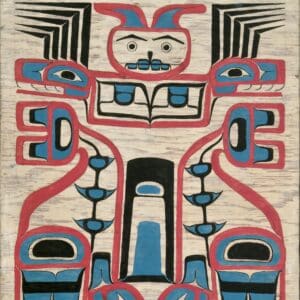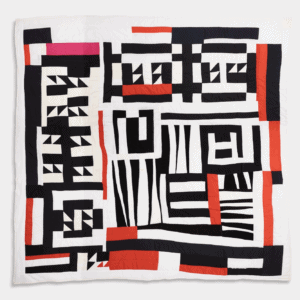May 16 through September 12, 2021
What happens when a particular community and its creative works come into contact with the mainstream art world? Roots examines this process and its aftermath, revealing hidden layers of meaning behind iconic American aesthetics.
- Detail: John Wallace (Native American, Haida, 1861 – 1950), Untitled, 1939, oil on panel. Philadelphia Museum of Art: A. E. Gallatin Collection, 1952 (1952-61-126)
- Artist/maker unknown (Shaker), Rocking Chair, 1840-1860, maple, hickory. Philadelphia Museum of Art: Gift of Mr. and Mrs. Julius Zieget, 1963 (1963-160-30)
- Mary Lee Bendolph (American, born 1935), Blocks, Strips, Strings, and Half Squares, 2005, pieced cotton plain weave, twill, corduroy, nylon twill, and cellulose acetate knit. Philadelphia Museum of Art: Purchased with the Phoebe W. Haas Fund for Costume and Textiles, and gift of the Souls Grown Deep Foundation from the William S. Arnett Collection, 2017 (2017-229-23) © Estate of Mary Lee Bendolph / Artists Rights Society (ARS), New York
The exhibition includes works by Plains and Northwest Coast Native Americans, the artists of Gee’s Bend, Alabama, an African American community known for their abstract quilts, and the Shakers—a religious sect that made furniture expressing their values of simplicity and order. These works will be displayed alongside art and design inspired by these traditions. Through these case studies, Roots raises important questions about inspiration, appropriation, and identity.
This is one in a series of American art exhibitions created through a multi-year, multi-institutional partnership formed by the Philadelphia Museum of Art as part of the Art Bridges Initiative.


In the News
- WVIA Public Media: Assistant Curator Claire McRee Speaking on Sleep Tight! and Roots
- Metro Philly Newspaper: Allentown Art Museum’s latest exhibit asks: What actually is American art?
- WFMZ-69News: Allentown Art Museum sharing some surprising insights into everyday objects in 2 new exhibits
The exhibition program at the Museum is supported through the generosity of The Bernard and Audrey Berman Foundation and the Leon C. and June W. Holt Endowment.




